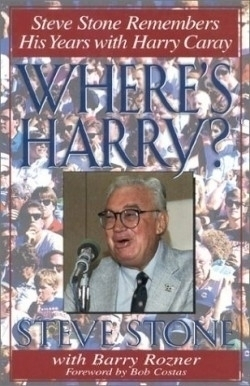Where's Harry?
Steve Stone Remembers His Years with Harry Caray
Holy Cow! Harry Caray fans will love this one! Stone has packed his book with humorous anecdotes, some of them knee-slapping funny, as he recounts his fifteen years at the microphone with baseball’s most beloved broadcaster. Former Orioles and White Sox Cy Young winner, Stone, with help from Barry Rozner, sports columnist for the Arlington Heights, Illinois “The Daily Herald,” tells it like it was. And what it was was mostly fun.
Caray’s broadcasting career started in 1945 in St. Louis where he called the Cardinals games for twenty-four years. He moved to Oakland for a year with the A’s in 1970, then to Chicago for ten years with the White Sox and the final fifteen years of his life with the Cubs. He was eighty-three when he died last year.
While Caray was well known throughout the Midwest, it was when he teamed up with the Cubs and super-station WGN-TV’s coast-to-coast coverage that he gained nation-wide popularity. It was here that he also teamed up with Stone. Stone played a willing second banana to Caray’s starring role, throwing in pertinent and clever observations form time-to-time, but most importantly knowing when to keep quiet and just let Caray talk.
Due to their close association on the air, the two were inseparable in the minds of the public and the title, “Where’s Harry?” evolved from the question Stone estimated he had been asked “a million times.” Wherever he went, whomever he met, the question was always “Where’s Harry?” Stone toyed with the idea of wearing a T-shirt under his suit that he could pop open every time he was asked and the shirt would say simply, “How the hell do I know?”
The truth was that if Caray wasn’t in the box with Stone, Stone rarely did know where he was. He knew that if it were after a night game, Caray would be in some neighborhood bar or some fancy downtown eatery; he just wouldn’t know which one. He also knew that wherever the establishment, Caray would be among the last to leave. One of his standing rules was that the menus were not to be brought to the table until he and his guests were sipping their fourth martini.
Those who have never heard of Caray might not find Stone’s reminiscences all that hilarious, but his fans will get a big charge out of his recalling such times as when Caray cut short a telephone conversation with President Reagan (which the station had gone to great pains to set up) because he had to get back to the game, and yelling at visitor Connie Stevens, “My God! How old are you? You’ve been around forever. You must really be getting up there!”
It becomes obvious early on in the book that Stone was as big a fan of Caray’s as any die-hard Cubs faithful follower, so while a few of Caray’s warts are exposed, do not look for any exposés; they are simply not there. What is there are hundreds of entertaining and revealing stories that might not win Stone a Pulitzer, but will give his fellow Harry Caray fans hours of enjoyment.
Reviewed by
Frank Sisson
Disclosure: This article is not an endorsement, but a review. The publisher of this book provided free copies of the book to have their book reviewed by a professional reviewer. No fee was paid by the publisher for this review. Foreword Reviews only recommends books that we love. Foreword Magazine, Inc. is disclosing this in accordance with the Federal Trade Commission’s 16 CFR, Part 255.

